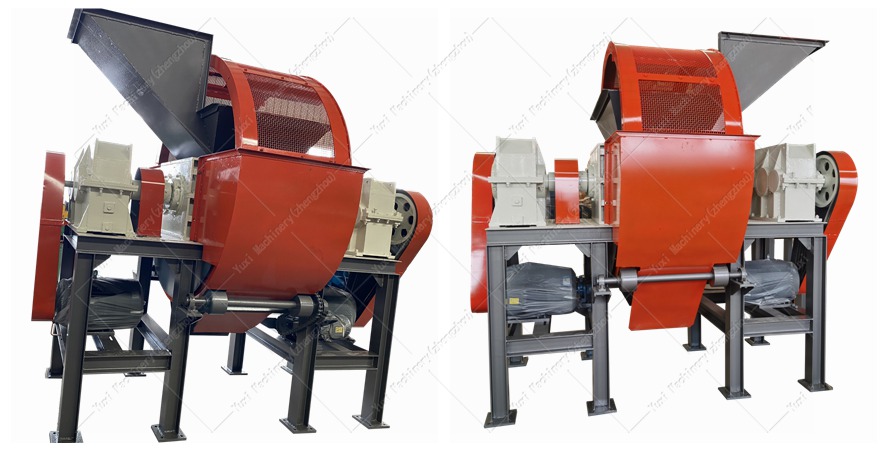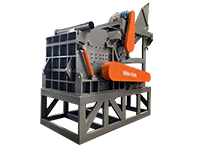As a core equipment in fields such as wood processing, garden solid waste disposal, and furniture manufacturing, the wood shredder has become a key link in the modern material handling system due to its technical advantages of efficient crushing, intelligent control, and environmental protection. This article will deeply analyze the professional details of the wood shredder from the dimensions of equipment principle, core components, technical parameters, application scenarios, and maintenance points, providing authoritative references for industry practitioners and purchasers.
1. Equipment Principle and Technical Architecture
The wood shredder adopts the closed shear crushing principle. Through the meshing and shearing of moving knives and fixed knives, materials such as wood, branches, and furniture scraps
can be translated as scraps or leftovers) are crushed into uniform wood chips. Its technical core lies in the controlled feeding system, which can precisely control the consistency of wood chip length to meet the standardized requirements of downstream production (such as biomass fuel and wood-based panel raw materials).
In terms of mechanical structure, the equipment is integrated with a PLC automatic control system, which has the functions of starting, stopping, reversing, and automatic reverse rotation in case of overload. It can monitor the operating status of the equipment in real time, realize unmanned operation and intelligent fault response, and greatly improve production efficiency and equipment safety.
2. Core Components and Material Advantages
1. Cutter System
The cutters are made of alloy material, which has both high wear resistance and impact resistance. According to the characteristics of different materials, a variety of cutter selections (such as single-edged, multi-edged, toothed knives, etc.) can be provided to ensure efficient crushing of various materials such as wood, garden waste, and furniture leftovers.
2. Transmission and Power System
The equipment is equipped with a low-speed, high-torque motor, which ensures the crushing force while reducing equipment vibration and noise, and realizes green production without dust pollution. Power transmission adopts V-belt drive, and with precise tension adjustment (it is appropriate to press the middle part to drop 2.36-3.94 inches), the efficient power transmission is ensured.
3. Bearings and Frame
The main shaft bearing needs to be regularly filled with butter for lubrication to avoid heat damage caused by long-term operation. The frame is welded with high-strength steel, with a compact structure and reasonable layout, which effectively reduces the floor area of the equipment and improves the site utilization rate.

3. Technical Parameters and Model Selection
Different models of wood shredders differ in parameters such as power, processing capacity, and size. The following is a comparison of the core parameters of typical models (using European and American standard units):
| Model | Power (Horsepower) | Processing Capacity | Material Size | Hopper Size | Equipment Weight | Overall Dimensions |
| YXS-600 | 40×2 | 2.2-3.3 Tons/Hour | 1.18-3.94 Inches | 32.28×35.43 Inches | 5511 Pounds | 8.53×6.56×6.23 Feet |
| YXS-1000 | 100×2 | 5.5-8.8 Tons/Hour | 1.18-3.94 Inches | 47.24×39.37 Inches | 12566 Pounds | 9.84×6.56×6.23 Feet |
| YXS-1600 | 200×2 | 13.2-19.8 Tons/Hour | 1.18-3.94 Inches | 90.55×78.74 Inches | 52911 Pounds | 16.40×9.84×7.87 Feet |
| YXS-2600 | 435×2 | 27.6-66.1 Tons/Hour | 1.18-3.94 Inches | 125.98×78.74 Inches | 187393 Pounds | 26.90×13.12×14.11 Feet |
When selecting a model, factors such as daily processing capacity, material type, and site conditions should be considered. If there is a high demand for production capacity and sufficient site, the YXS-2600 model can be preferred; if it is used for the treatment of leftover materials in small gardens or furniture factories, the compact design and moderate production capacity of the YXS-600 model are more suitable.
4. Application Scenarios and Industry Value
1. Wood Processing Industry
Crush logs and plate scraps into standard wood chips, which are used as raw materials for wood-based panels, papermaking, and biomass pellets to realize the efficient use of wood resources.
2. Garden Solid Waste Treatment
Crush garden wastes such as branches, dead wood, and fallen leaves to reduce garbage removal costs, and at the same time provide raw materials for organic mulch and compost.
3. Furniture Manufacturing Field
Treat the leftover materials in the furniture production process. After crushing, they can be used as fillers or re-enter the production process, helping enterprises achieve the goal of "zero waste" production.
5. Maintenance Points and Life Extension Strategies
1. Bearing Maintenance
The bearing lubrication should be checked every 500 hours of operation, and high-temperature butter should be added in time to prevent the bearing from being damaged by heat due to lack of oil.
2. V-Belt Management
Regularly check the tension of the V-belt. If it is loose, it should be adjusted in time to avoid power loss or belt wear caused by slipping.
3. Cutter Maintenance
According to the wear degree of the crushed materials, the cutters should be sharpened or replaced every 300-500 hours to ensure the shearing efficiency; the alloy cutters can be repaired by surfacing to reduce the cost of consumables.

6. Professional Q&A Session
1. What is the technical principle of the overload automatic reverse function of the PLC control system of the wood shredder?
Answer: The PLC collects signals such as motor current and spindle speed. When it detects that the load exceeds the set threshold, it triggers the reverse program to make the cutter run in reverse to discharge the stuck material. After the load returns to normal, it automatically switches to forward rotation to ensure the continuous operation of the equipment.
2. What are the advantages of the wear resistance of alloy cutters? And how much can the service life be extended compared with ordinary steel cutters?
Answer: Alloy cutters form a metallographic structure with high hardness and high toughness by adding alloy elements such as tungsten and chromium, which can effectively resist wear and impact when shearing wood. Compared with ordinary steel cutters, their service life can be extended by 3-5 times.
3. A furniture factory needs to process 8 tons of leftover materials every day, and the site size is 19.69×13.12 feet. Which model of wood shredder should be preferred?
Answer: Considering the processing capacity (8 tons/day, that is, about 1 ton per hour, and redundancy should be reserved considering equipment efficiency) and site size, the YXS-1000 model (processing capacity 5.5-8.8 tons/hour, overall dimensions 9.84×6.56×6.23 feet) is the best choice, and its production capacity and site adaptability can meet the needs.
Through the in-depth analysis of the wood shredder, it is not difficult to find its professional value in technical design, component configuration, and industry adaptability. Whether it is a wood processing enterprise pursuing efficient production or an environmental protection institution committed to solid waste resource utilization, choosing a wood shredder that meets its own needs will inject strong momentum into production efficiency and green development.
 Shredding Machine
Shredding Machine
 Waste Recycling Line
Waste Recycling Line
 Optional Equipment
Optional Equipment


